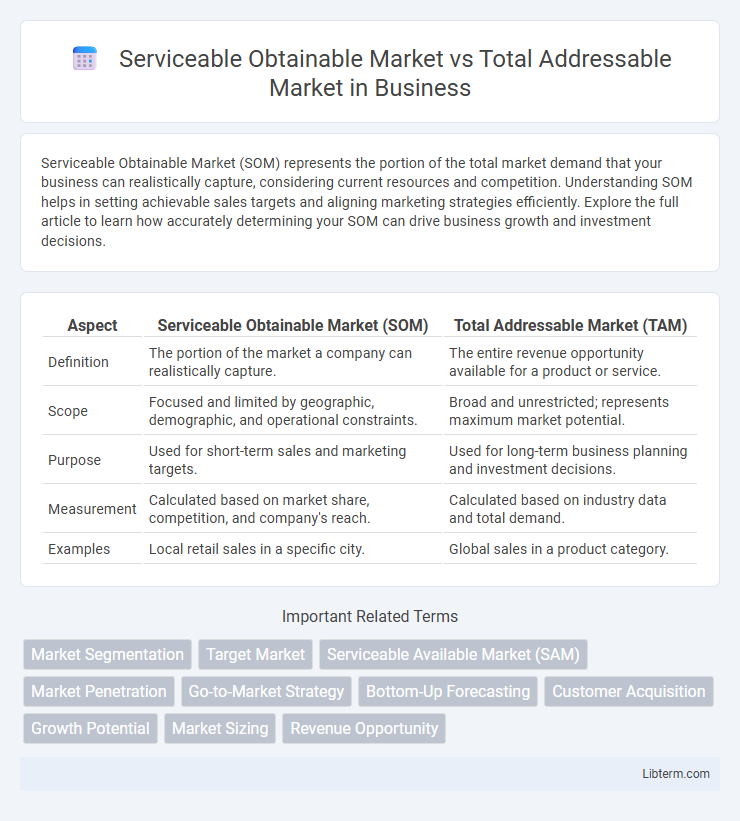Serviceable Obtainable Market (SOM) represents the portion of the total market demand that your business can realistically capture, considering current resources and competition. Understanding SOM helps in setting achievable sales targets and aligning marketing strategies efficiently. Explore the full article to learn how accurately determining your SOM can drive business growth and investment decisions.
Table of Comparison
| Aspect | Serviceable Obtainable Market (SOM) | Total Addressable Market (TAM) |
|---|---|---|
| Definition | The portion of the market a company can realistically capture. | The entire revenue opportunity available for a product or service. |
| Scope | Focused and limited by geographic, demographic, and operational constraints. | Broad and unrestricted; represents maximum market potential. |
| Purpose | Used for short-term sales and marketing targets. | Used for long-term business planning and investment decisions. |
| Measurement | Calculated based on market share, competition, and company's reach. | Calculated based on industry data and total demand. |
| Examples | Local retail sales in a specific city. | Global sales in a product category. |
Understanding Total Addressable Market (TAM)
Total Addressable Market (TAM) represents the overall revenue opportunity available for a product or service, assuming 100% market share and unlimited resources. It quantifies the full demand within a specific market segment to help businesses gauge growth potential and justify investment. Understanding TAM ensures companies target scalable opportunities and align product development with market size.
Defining Serviceable Obtainable Market (SOM)
Serviceable Obtainable Market (SOM) represents the portion of the Total Addressable Market (TAM) that a company can realistically capture, considering current resources, competition, and market constraints. SOM is defined by analyzing factors such as geographic reach, target customer segments, and operational capabilities, making it a practical and achievable market size estimate. Accurate SOM calculation is essential for effective business planning, budgeting, and setting realistic sales targets.
TAM vs. SOM: Key Differences
The Total Addressable Market (TAM) represents the overall revenue opportunity available for a product or service, reflecting the maximum market demand if there were no competitors or constraints. The Serviceable Obtainable Market (SOM) is a subset of TAM that identifies the portion realistically achievable by a company, considering factors like competition, market reach, and operational capacity. The key difference lies in TAM's broad potential scope versus SOM's practical focus on market share a business can capture in the near term.
Why Market Segmentation Matters
Market segmentation refines the Total Addressable Market (TAM) into specific, reachable customer groups, allowing businesses to focus on the Serviceable Obtainable Market (SOM) that represents realistic revenue opportunities. Understanding distinct segments improves targeting efficiency, optimizes resource allocation, and enhances product-market fit by addressing unique customer needs. Precise segmentation minimizes market risks and increases the likelihood of capturing high-value customers within the feasible operational scope.
Calculating Your TAM Effectively
Calculating your Total Addressable Market (TAM) effectively requires identifying the entire revenue opportunity available if your product or service captured 100% market share, often derived from industry reports, government data, and competitor analysis. To refine this, focus on the Serviceable Obtainable Market (SOM), which represents the realistically reachable segment within the TAM, considering current resources, geographic reach, and competitive landscape, often calculated using customer segmentation and market penetration rates. Precise TAM and SOM calculations enable strategic investment decisions and targeted marketing efforts, optimizing resource allocation for maximum growth potential.
Estimating Your SOM Accurately
Estimating your Serviceable Obtainable Market (SOM) accurately requires analyzing market penetration rates, customer segments, and competitor share within the Total Addressable Market (TAM). Utilize granular data such as geographic demand, product fit, and sales channel effectiveness to refine SOM projections. Precise estimation of SOM enables targeted resource allocation and realistic revenue forecasting for sustainable business growth.
The Importance of Targeting Your SOM
Serviceable Obtainable Market (SOM) represents the realistic portion of the Total Addressable Market (TAM) that a business can capture given current resources and competition. Targeting your SOM allows for more precise marketing strategies, optimized resource allocation, and achievable revenue forecasting. Focusing on SOM helps startups and established companies prioritize efforts on the most accessible customer segments, improving growth efficiency and investor confidence.
Real-World Examples: TAM and SOM in Action
The Total Addressable Market (TAM) for electric vehicles (EVs) includes all global car buyers, estimated at over $800 billion annually, while the Serviceable Obtainable Market (SOM) narrows to companies like Tesla targeting premium EV buyers in North America and Europe, representing around $50 billion. In the software industry, Microsoft's TAM for cloud services spans the entire global enterprise IT spend exceeding $500 billion, yet its SOM focuses on medium-to-large enterprises readily adopting Azure, roughly accounting for $80 billion. These examples showcase how TAM sets the broad market potential and SOM reflects realistic, immediate revenue opportunities for specific products or companies.
Common Mistakes in Market Sizing
Confusing Serviceable Obtainable Market (SOM) with Total Addressable Market (TAM) leads to overestimating potential revenue by failing to consider realistic market penetration and competitive constraints. Ignoring distribution capabilities and customer acquisition costs often results in overstated SOM, misguiding strategic decisions. Accurate market sizing requires distinguishing TAM as the broadest revenue opportunity and SOM as the achievable share within operational limits.
Leveraging TAM and SOM for Business Growth
Leveraging Total Addressable Market (TAM) provides a broad perspective of the maximum revenue opportunity for a product or service, while focusing on Serviceable Obtainable Market (SOM) highlights the realistic market segment a business can capture based on current resources and competitive environment. Prioritizing SOM enables targeted marketing strategies and efficient allocation of sales efforts, driving sustainable business growth within achievable market boundaries. Integrating TAM analysis with SOM assessment helps businesses identify expansion opportunities and refine product offerings to scale effectively.
Serviceable Obtainable Market Infographic

 libterm.com
libterm.com